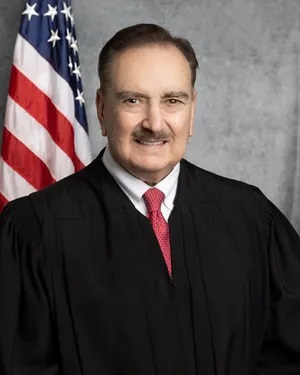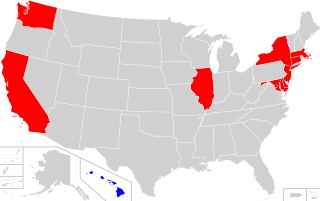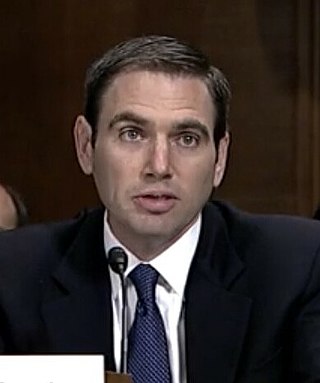
The National Firearms Act (NFA), 73rd Congress, Sess. 2, ch. 757, 48 Stat. 1236 was enacted on June 26, 1934, and currently codified and amended as I.R.C. ch. 53. The law is an Act of Congress in the United States that, in general, imposes an excise tax on the manufacture and transfer of certain firearms and mandates the registration of those firearms. The NFA is also referred to as Title II of the federal firearms laws, with the Gun Control Act of 1968 ("GCA") as Title I.
A hell-fire trigger is a device that allows a semi-automatic firearm to fire at an increased rate. The hell-fire clamps to the trigger guard behind the trigger and presses a "finger" against the back of the trigger to increase the force that returns the trigger to its forward position, effectively decreasing the time required for the trigger to reset, allowing for a faster follow up shot.

Bump stocks or bump fire stocks are gun stocks that can be used to assist in bump firing, the act of using the recoil of a semi-automatic firearm to fire cartridges in rapid succession.

Short-barreled rifle broadly refers to any rifle with an unusually short barrel. The term carbine describes a production rifle with a reduced barrel length for easier handling in confined spaces. Concern about concealment for illegal purposes has encouraged regulations specifying minimum barrel lengths and overall lengths.
In the United States, the right to keep and bear arms is modulated by a variety of state and federal statutes. These laws generally regulate the manufacture, trade, possession, transfer, record keeping, transport, and destruction of firearms, ammunition, and firearms accessories. They are enforced by state, local and the federal agencies which include the Bureau of Alcohol, Tobacco, Firearms and Explosives (ATF).

Title II weapons, or NFA firearms, are designations of certain weapons under the United States National Firearms Act (NFA).

Gun laws in California regulate the sale, possession, and use of firearms and ammunition in the state of California in the United States.

David Alan Ezra is a senior United States district judge of the United States District Court for the District of Hawaii. Since January 2013, Ezra has been designated by the Chief Justice of the United States Supreme Court to serve on the United States District Court for the Western District of Texas, San Antonio and Austin Divisions to help ease the heavy workload for the federal judges in Texas. Judge Ezra is often designated to sit on the United States Court of Appeals for the Ninth Circuit where he holds the record for the most designated sittings of any judge in that Court’s history.

Reed Charles O'Connor is a United States district judge of the United States District Court for the Northern District of Texas. He was nominated by President George W. Bush in 2007.
The Roberti–Roos Assault Weapons Control Act of 1989 (AWCA) is a California law that bans the ownership and transfer of over 50 specific brands and models of firearms, which were classified as assault weapons. Most were rifles, but some were pistols and shotguns. The law was amended in 1999 to classify assault weapons by features of the firearm. Firearms that were legally owned at the time the law was passed were grandfathered if they were registered with the California Department of Justice. The law was overturned in June 2021 in Miller v. Bonta; the ruling is stayed pending appeal.

Assault weapons legislation in the United States refers to bills and laws that define and restrict or make illegal the manufacture, transfer, and possession of assault weapons. How these firearms are defined and regulated varies from jurisdiction to jurisdiction; generally, this constitutes a list of specific firearms and combinations of features on semiautomatic firearms.

On October 1, 2017, a mass shooting occurred when 64-year-old Stephen Paddock opened fire on the crowd attending the Route 91 Harvest music festival on the Las Vegas Strip in Nevada from his 32nd-floor suites in the Mandalay Bay hotel. He fired more than 1,000 rounds, killing 60 people and wounding at least 413. The ensuing panic brought the total number of injured to approximately 867. About an hour later, he was found dead in his room from a self-inflicted gunshot wound. The motive for the shooting is officially undetermined.

Eric Earl Murphy is an American lawyer and jurist serving since 2019 as a U.S. circuit judge of the U.S. Court of Appeals for the Sixth Circuit. He previously served as the Solicitor General of Ohio from 2013 to 2019.

A homemade firearm, also called a ghost gun or privately made firearm, is a firearm made by a private individual, in contrast to one produced by a corporate or government entity. The term ghost gun is used mostly in the United States by gun control advocates, but it is being adopted by gun rights advocates and the firearm industry.
New York State Rifle & Pistol Association, Inc. v. Bruen, 597 U.S. 1 (2022), abbreviated NYSRPA v. Bruen and also known as NYSRPA II or Bruen to distinguish it from the 2020 case, is a landmark decision of the United States Supreme Court related to the Second Amendment to the United States Constitution. The case concerned the constitutionality of the 1911 Sullivan Act, a New York State law requiring applicants for a pistol concealed carry license to show "proper cause", or a special need distinguishable from that of the general public, in their application.

A Glock switch is a small device that can be attached to the rear of the slide of a Glock handgun, changing the semi-automatic pistol into a selective fire machine pistol capable of fully automatic fire. As a type of auto sear, it functions by applying force to the trigger bar to prevent it from limiting fire to one round of ammunition per trigger pull. This device by itself, regardless if it is installed on a slide or not, is considered by the Bureau of Alcohol, Tobacco, Firearms and Explosives (ATF) to be a machine gun, making possession of the device illegal in the United States under most circumstances.
A binary trigger is a type of device that allows a semi-automatic firearm to fire at an increased rate. A binary trigger works by firing one shot upon pulling the trigger and then firing a subsequent shot upon release of the trigger.

A forced reset trigger is a device that allows a person to fire a semi-automatic firearm at an increased rate. The forced reset trigger works by mechanically resetting the trigger's position after a shot is fired. This allows for an increased rate of fire. However, the shooter must still manually pull the trigger each time it resets for any subsequent shot to be fired.

The Firearms Policy Coalition (FPC) is a gun rights organization in the United States, which aims to advance gun rights in the United States via legal action, in keeping with its stated goal to "restore the essential right to keep and bear arms in the United States." The FPC seeks to approach gun rights advocacy in a more targeted and effective way than the National Rifle Association of America (NRA), specifically by working with targeted legal teams to advance legislation in support of gun rights causes.
Michael Cargill is an American gun rights activist. He is the host of the gun rights radio show, Come And Talk It. He is also the owner of Central Texas Gun Works.














